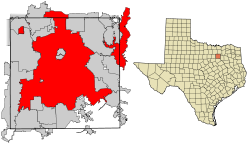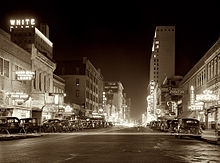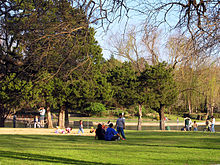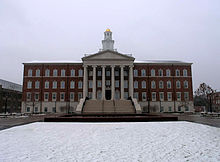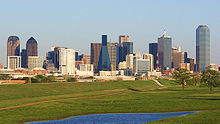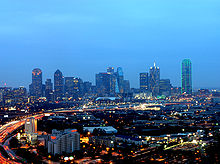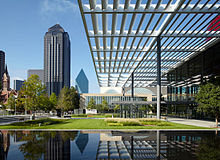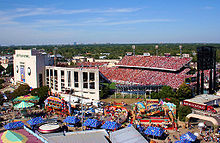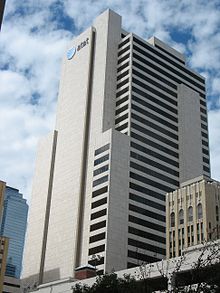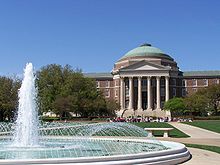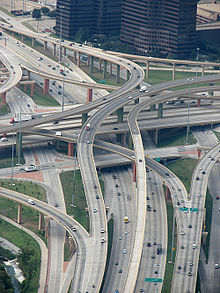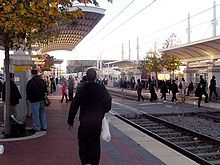- Dallas
-
This article is about the city in the U.S. state of Texas. For other uses, see Dallas (disambiguation).
Dallas, Texas — City — Dallas Clockwise from top: Downtown Dallas from the Trinity River Greenbelt Park, the Meyerson Symphony Center, the Southern Methodist University (SMU) campus, and Bank of America Plaza 
Flag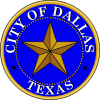
SealNickname(s): "Big D" Location in Dallas County and the state of Texas Location in the United States Coordinates: 32°46′58″N 96°48′14″W / 32.78278°N 96.80389°WCoordinates: 32°46′58″N 96°48′14″W / 32.78278°N 96.80389°W Country United States State Texas Incorporated February 2, 1856 Counties Dallas, Collin, Denton, Rockwall, Kaufman Government – Type Council-Manager – Body Dallas City Council – Mayor Mike Rawlings Area – City 385.0 sq mi (997.1 km2) – Land 342.5 sq mi (887.2 km2) – Water 42.5 sq mi (110.0 km2) Elevation 430 ft (131 m) Population (2010 United States Census)[1] – City 1,197,816 (9th U.S.) – Density 3,697.44/sq mi (1,427.38/km2) – Metro 6,477,315 (4th U.S.) – Demonym Dallasite Time zone Central (UTC-6) – Summer (DST) Central (UTC-5) Area code 214, 469, 972 FIPS code 48-19000[2] GNIS feature ID 1380944[3] ZIP code prefix 752,753 Primary Airport Dallas/Fort Worth International Airport- DFW (Major/International) Secondary Airport Dallas Love Field- DAL (Major) Website dallascityhall.com Dallas (
 /ˈdæləs/) is the third-largest city in Texas[4][5] and the ninth-largest in the United States. The Dallas-Fort Worth Metroplex is the largest metropolitan area in the South and fourth-largest metropolitan area in the United States.[6][7][8] Divided between Collin, Dallas, Denton, Kaufman, and Rockwall counties, the city had a 2010 population of approximately 1.2 million, according to the United States Census Bureau.[9]
/ˈdæləs/) is the third-largest city in Texas[4][5] and the ninth-largest in the United States. The Dallas-Fort Worth Metroplex is the largest metropolitan area in the South and fourth-largest metropolitan area in the United States.[6][7][8] Divided between Collin, Dallas, Denton, Kaufman, and Rockwall counties, the city had a 2010 population of approximately 1.2 million, according to the United States Census Bureau.[9]The city is the largest economic center of the 12-county Dallas–Fort Worth–Arlington metropolitan area (the DFW MSA) that according to the March 2010 U.S. Census Bureau release, had a population of roughly 6.5 million as of July 2009.[10] The metroplex economy is the sixth largest in the United States, with a 2010 gross metropolitan product of $374 billion.[11]
Dallas was founded in 1841 and was formally incorporated as a city in February 1856. The city's economy is primarily based on banking, commerce, telecommunications, computer technology, energy, healthcare and medical research, transportation and logistics. The city is home to the third largest concentration of Fortune 500 companies in the nation.[12] Located in North Texas and a major city in the American South, Dallas is the main core of the largest inland metropolitan area in the United States that lacks any navigable link to the sea.[13]
The city's prominence arose from its historical importance as a center for the oil and cotton industries, and its position along numerous railroad lines. With the advent of the interstate highway system in the 1950's and 1960's, Dallas became an east/west and north/south focal point of the interstate system with the convergence of four major interstate highways in the city, along with a fifth interstate loop around the city. Dallas developed a strong industrial and financial sector, and a major inland port, due largely to the presence of Dallas/Fort Worth International Airport, one of the largest and busiest airports in the world.[14]
In the latest rankings released on September 14, 2011, Dallas was rated as an Alpha- world city by the Globalization and World Cities Study Group & Network and is the only city in the South Central and Southwest regions to achieve that status. Dallas is also ranked 14th in world rankings of GDP by the Organization for Economic Co-operation and Development.[15]
Contents
History
Main article: History of DallasSee also: Historical events of DallasBefore Texas was claimed in the 18th century as a part of the Viceroyalty of New Spain by the Spanish Empire, the Dallas neman area was inhabited by the Caddo people. Later, France also claimed the area, but in 1819 the Adams-Onís Treaty made the Red River the northern boundary of New Spain, officially placing the future location of Dallas well within Spanish territory.[16] The area remained under Spanish rule until 1821, when Mexico declared independence from Spain and the area became part of the Mexican state of Coahuila y Tejas. In 1836, the Republic of Texas broke off from Mexico to become an independent nation.[17] In 1839, Warren Angus Ferris surveyed the area around present-day Dallas. Two and a half years later, John Neely Bryan established a permanent settlement near a river he found and called that settlement Dallas. The Republic of Texas was then annexed by the United States in 1845 and Dallas County was established the following year. Dallas was formally incorporated as a city in February 1856. The name of the city has uncertain origins. See History of Dallas, Texas (1839-1855) for more information on that.
Geography
Dallas is the county seat of Dallas County. Portions of the city extend into neighboring Collin, Denton, Kaufman, and Rockwall counties. According to the United States Census Bureau, the city has a total area of 385 square miles (997.1 km2), 342.5 square miles (887.1 km2) of it being land and 42.5 square miles (110.1 km2) of it (11.03%) water. Dallas makes up one-fifth of the much larger urbanized area known as the Dallas–Fort Worth Metroplex, in which one quarter of all Texans live.
Topography
Main article: Geology of the Dallas-Fort Worth MetroplexDallas and its surrounding area are mostly flat; the city itself lies at elevations ranging from 450 feet (137 m) to 550 feet (168 m). The western edge of the Austin Chalk Formation, a limestone escarpment (also known as the "White Rock Escarpment"), rises 200 feet (61 m) and runs roughly north-south through Dallas County. South of the Trinity River, the uplift is particularly noticeable in the neighborhoods of Oak Cliff and the adjacent cities of Cockrell Hill, Cedar Hill, Grand Prairie, and Irving. Marked variations in terrain are also found in cities immediately to the west in Tarrant County surrounding Fort Worth, as well as along Turtle Creek north of Downtown.
Dallas, like many other cities in the world, was founded along a river. The city was founded at the location of a "white rock crossing" of the Trinity River, where it was easier for wagons to cross the river in the days before ferries or bridges. The Trinity River, though not usefully navigable, is the major waterway through the city. Its path through Dallas is paralleled by Interstate 35E along the Stemmons Corridor, then south alongside the western portion of Downtown and past south Dallas and Pleasant Grove, where the river is paralleled by Interstate 45 until it exits the city and heads southeast towards Houston. The river is flanked on both sides by 50 feet (15 m) tall earthen levees to protect the city from frequent floods.[18] Since it was rerouted in 1908, the river has been little more than a drainage ditch within a floodplain for several miles above and below downtown Dallas, with a more normal course further upstream and downstream, but as Dallas began shifting towards postindustrial society, public outcry about the lack of aesthetic and recreational use of the river ultimately gave way to the Trinity River Project,[19] which was initialized in the early 2000s and is scheduled to be completed in the 2010s. If the project materializes fully, it promises improvements to the riverfront in the form of man-made lakes, new park facilities and trails, and transportation upgrades.
The project area will reach for over 20 miles (32 km) in length within the city, while the overall geographical land area addressed by the Land Use Plan is approximately 44,000 acres (180 km2) in size—about 20% of the land area in Dallas. Green space along the river will encompass approximately 10,000 acres (40 km2), making it one of the largest and diverse urban parks in the world.[20]
White Rock Lake, a reservoir constructed at the beginning of the 20th century, is Dallas' other significant water feature. The lake and surrounding park is a popular destination for boaters, rowers, joggers, and bikers, as well as visitors seeking peaceful respite from the city at the 66-acre (267,000 m2) Dallas Arboretum and Botanical Garden, located on the lake's eastern shore. White Rock Creek feeds into White Rock Lake, and then exits on to the Trinity River southeast of downtown Dallas. Trails along White Rock Creek are part of the extensive Dallas County Trails System. Bachman Lake, just northwest of Love Field Airport, is a smaller lake also popularly used for recreation. Northeast of the city is Lake Ray Hubbard, a vast 22,745-acre (92 km2) reservoir located in an extension of Dallas surrounded by the suburbs of Garland, Rowlett, Rockwall, and Sunnyvale.[21] To the west of the city is Mountain Creek Lake, once home to the Naval Air Station Dallas (Hensley Field) and a number of defense aircraft manufacturers.[22] North Lake, a small body of water in an extension of the city limits surrounded by Irving and Coppell, initially served as a water source for a nearby power plant but is now being targeted for redevelopment as a recreational lake due to its proximity to Dallas-Fort Worth International Airport, a plan that the lake's neighboring cities oppose.[23]
Climate
Main article: Climate of DallasDallas has a humid subtropical climate, though it is located in a region that also tends to receive warm, dry winds from the north and west in the summer, bringing temperatures well over 100 °F (38 °C) at times and heat-humidity indexes soaring to as high as 117 °F (47 °C). When only temperature itself is accounted for, the north central Texas region where Dallas is located is one of the hottest in the United States during the summer months, usually trailing only the Mojave Desert basin of Arizona, southern Nevada, and southeastern California.
Winters in Dallas are generally mild, with normal daytime highs ranging from 55 °F (13 °C) to 70 °F (21 °C) and normal nighttime lows falling in between 30 °F (−1 °C) and 45 °F (7 °C). A day with clear, sunny skies, a high of 63 °F (17 °C), and a low of 36 °F (2 °C) would thus be a very typical one during the winter. However, strong cold fronts known as "Blue Northers" sometimes pass through the Dallas region, plummeting nightly lows below 25 °F (−4 °C) for up to a few days at a time and keeping daytime highs in a struggle to surpass 40 °F (4 °C). Snow accumulation is usually seen in the city at least once every winter, and snowfall generally occurs 2–3 days out of the year for an annual average of 2.5 inches (6.4 cm). Some areas in the region, however, receive more than that, while other areas receive negligible snowfall or none at all.[24] A couple of times each winter in Dallas, warm and humid air from the south will override cold, dry air, resulting in freezing rain or ice and causing disruptions in the city if the roads and highways become slick. On the other hand, daytime highs above 70 °F (21 °C) are not unusual and will occur at least several days each winter month—roughly the same number of days each December, January, and February that low temperatures fall below 30 °F (−1 °C) or that high temperatures fail to reach 50 °F (10 °C). Over the past 15 years, Dallas has averaged 31 annual nights at or below freezing, with the winter of 1999–2000 holding the all-time record as having the fewest freezing nights, with 14. During this same span of 15 years, the temperature in the region has only twice dropped below 15 °F (−9 °C), though it will generally fall below 20 °F (−7 °C) about once every other year.[25] In sum, extremes and variations in winter weather are more readily seen in Dallas and Texas as a whole than along the Pacific and Atlantic coasts, due to the state's location in the interior of the North American continent and the lack of any mountainous terrain to the north to block out Arctic weather systems.
Spring and autumn bring pleasant weather to the area. Vibrant wildflowers (such as the bluebonnet, Indian paintbrush and other flora) bloom in spring and are planted around the highways throughout Texas.[26] Springtime weather can be quite volatile, but temperatures themselves are mild. The weather in Dallas is also generally pleasant from late September to early December and on many winter days, but unlike in the springtime, major storms rarely form in the area.
Each spring, cool fronts moving south from the North will collide with warm, humid air streaming in from the Gulf Coast, leading to severe thunderstorms with lightning, torrents of rain, hail, and occasionally, tornadoes. Over time, tornadoes have probably been the biggest natural threat to the city, as it is located near the heart of Tornado Alley.
The U.S. Department of Agriculture places Dallas in Plant Hardiness Zone 8a.[27][28] However, mild winter temperatures in the past 15 to 20 years have encouraged the horticulture of some cold-sensitive plants such as Washingtonia filifera and Washingtonia robusta palms. According to the American Lung Association, Dallas has the 12th highest air pollution among U.S. cities, ranking it behind Los Angeles and Houston.[29] Much of the air pollution in Dallas and the surrounding area comes from a hazardous materials incineration plant in the small town of Midlothian and from concrete installations in neighbouring Ellis County.[30]
The city's all-time recorded high temperature is 113 °F (45 °C), while the all-time recorded low is −8 °F (−22 °C). The average daily low in Dallas is 55.0 °F (12.8 °C), and the average daily high in Dallas is 76.3 °F (24.6 °C).[31] Dallas receives approximately 33.3 inches (845.8 mm) of rain per year.[32]
Dallas Climate chart (explanation) J F M A M J J A S O N D 1.955342.460383.168463.276545.283633.291712.19675296742.488674.179572.667452.65837Average max. and min. temperatures in °F Precipitation totals in inches Metric conversion J F M A M J J A S O N D 481316015378208812412131291782332154352452362361311910426146519765153Average max. and min. temperatures in °C Precipitation totals in mm Climate data for Dallas (DFW Airport) Month Jan Feb Mar Apr May Jun Jul Aug Sep Oct Nov Dec Year Record high °F (°C) 93
(34)96
(36)100
(38)101
(38)107
(42)113
(45)110
(43)112
(44)111
(44)106
(41)89
(32)90
(32)113
(45)Average high °F (°C) 54.9
(12.7)59.5
(15.3)67.8
(19.9)75.9
(24.4)83.3
(28.5)91.2
(32.9)95.7
(35.4)95.9
(35.5)88.3
(31.3)78.8
(26.0)66.5
(19.2)58.1
(14.5)76.3 Average low °F (°C) 34.2
(1.2)37.9
(3.3)45.6
(7.6)54.3
(12.4)63.2
(17.3)70.6
(21.4)74.6
(23.7)74.2
(23.4)67.0
(19.4)56.5
(13.6)45.1
(7.3)37.2
(2.9)55.0 Record low °F (°C) −2
(−18.9)−8
(−22.2)10
(−12.2)29
(−1.7)34
(1)48
(9)56
(13)55
(13)40
(4)24
(−4.4)19
(−7.2)−1
(−18.3)−8
(−22.2)Precipitation inches (mm) 1.90
(48.3)2.37
(60.2)3.06
(77.7)3.20
(81.3)5.15
(130.8)3.23
(82)2.12
(53.8)2.03
(51.6)2.42
(61.5)4.11
(104.4)2.57
(65.3)2.57
(65.3)34.73
(882.1)Snowfall inches (cm) .8
(2)1.2
(3).1
(0.3)0
(0)0
(0)0
(0)0
(0)0
(0)0
(0)0
(0).2
(0.5).2
(0.5)2.5
(6.4)Avg. precipitation days (≥ 0.01 in) 7.2 6.3 7.8 7.1 9.3 7.2 4.3 4.5 5.9 6.7 6.4 6.5 79.2 Avg. snowy days (≥ 0.1 in) .5 .7 .2 0 0 0 0 0 0 0 .1 .4 1.9 Sunshine hours 182.9 180.8 226.3 237.0 257.3 297.0 331.7 303.8 246.0 229.4 183.0 173.6 2,848.8 Source no. 1: National Weather Service (normals from 1971–2000) [31], Source no. 2: HKO (sun hr, 1961–1990) [33] Cityscape
Architecture
See also: List of Dallas Landmarks and List of tallest buildings in DallasDallas' skyline contains several buildings over 700 feet (210 m) in height. Although some of Dallas' architecture dates from the late 19th and early 20th centuries, most of the notable architecture in the city is from the modernist and postmodernist eras. Iconic examples of modernist architecture include Reunion Tower, the JFK Memorial, I. M. Pei's Dallas City Hall and Morton H. Meyerson Symphony Center. Good examples of postmodernist skyscrapers are in Fountain Place, Bank of America Plaza, Renaissance Tower, JPMorgan Chase Tower, and Comerica Bank Tower. Several smaller structures are fashioned in the Gothic Revival style, such as the Kirby Building, and the neoclassical style, as seen in the Davis and Wilson Buildings. One architectural "hotbed" in the city is a stretch of historic houses along Swiss Avenue, which contains all shades and variants of architecture from Victorian to neoclassical.[34] The Dallas Downtown Historic District protects a cross-section of Dallas commercial architecture from the 1880s to the 1940s.
Neighborhoods
See also: List of neighborhoods in DallasCentral Dallas is anchored by Downtown, the center of the city and the epicenter of urban revival, along with Oak Lawn and Uptown, areas characterized by dense retail, restaurants, and nightlife. Downtown Dallas has a variety of named districts, including the West End Historic District, the Arts District, the Main Street District, Farmers Market District, the City Center business district, the Convention Center District, and the Reunion District. "Hot spots" north of Downtown include Uptown, Victory Park, Oak Lawn, Turtle Creek, Cityplace and West Village.
East Dallas is home to Deep Ellum, a trendy arts area close to Downtown, the homey Lakewood neighborhood, historic Vickery Place and Bryan Place, and the architecturally significant Swiss Avenue. North of the Park Cities is Preston Hollow, home to Texas' wealthiest residents, as well as the most expensive homes in the state. The area is also characterized by a variety of high-powered shopping areas, including Galleria Dallas, NorthPark Center, and Highland Park Village. In the northeast quadrant of the city is Lake Highlands, one of Dallas' most unified middle-class neighborhoods.[35]
Midtown Dallas is currently undergoing construction of new high-rise apartments, restaurants, and retail. The midtown area is generally a new classification of the city, consisting of North Park Mall, SMU, White Rock Lake, The Dallas Arboretum, and new retail/high-rises, most notably along Park Lane and Central Expressway. Midtown is bordered by University Park to the west, Preston Hollow to the North, Lake Highlands/Lakewood to the East, and Uptown/City Place to the South.
Southwest of Downtown lies Oak Cliff, a hilly area that has undergone gentrification in recent years in neighborhoods such as the Bishop Arts District. Oak Cliff originated as a township founded in the mid-1800s and was annexed by the city of Dallas in 1903.[36] Today, most of the area's northern residents are Hispanic. The ghost town of La Reunion once occupied the northern tip of Oak Cliff. South Oak Cliff is a mixture of Black/African American, Hispanic, and Native American.
South Dallas, a distinct neighborhood southeast of Downtown, lays claim to the Cedars, an eclectic artist hotbed south of downtown and Fair Park, home of the annual State Fair of Texas, occurring in October.
Much of the southern portion of the city is characterized now by high rates of poverty and crime.[37] To spur growth in the southern sector of the city, University of North Texas System opened a Dallas campus in October 2006 in South Oak Cliff near the intersection of Interstate 20 and Houston School Rd.[38] Large amounts of undeveloped land remain nearby, due to decades of slow growth south of Downtown. Further east, in the southeast quadrant of the city, is the large neighborhood of Pleasant Grove. Once an independent city, it is a collection of mostly lower-income residential areas stretching all the way to Seagoville in the southeast. Though a city neighborhood, Pleasant Grove is surrounded by undeveloped land on all sides, including swampland separating it from South Dallas that will in the future be part of the Great Trinity Forest,[39] a subsection of the city's Trinity River Project.
Dallas is further surrounded by many suburbs and includes three enclaves within the city boundaries—Cockrell Hill, Highland Park, and University Park.
Culture
 Stone Street Gardens is lined with bistros, pubs and restaurants connecting Main to Elm Streets in Downtown Dallas
Stone Street Gardens is lined with bistros, pubs and restaurants connecting Main to Elm Streets in Downtown Dallas Main article: Culture of Dallas
Main article: Culture of DallasCuisine
Dallas is known for its barbecue, authentic Mexican, and Tex-Mex cuisine. Famous products of the Dallas culinary scene include the frozen margarita and the chain restaurants Chili's and Romano's Macaroni Grill.[40] Fearing's restaurant at the Ritz-Carlton Dallas hotel in Uptown Dallas was named the best hotel restaurant in the US for 2009 by Zagat Survey. The Ritz-Carlton Dallas hotel was also named 2009 best US hotel by Zagat, and 2009 No. 2 hotel in the world by Zagat, trailing only the Four Seasons King George V in Paris, France. A number of nationally ranked steakhouses can be found in the Dallas area, including Bob's Steak & Chop House, currently ranked No. 1 according to the USDA Prime Steakhouses chart.[41]
Arts
The Arts District in the northern section of Downtown is home to several arts venues, both existing and proposed. Notable venues in the district include the Dallas Museum of Art, the Morton H. Meyerson Symphony Center (home of the Dallas Symphony Orchestra), The Trammell & Margaret Crow Collection of Asian Art, the Nasher Sculpture Center, The Dallas Contemporary, and The Dallas Children's Theater.
Venues that are part of the AT&T Dallas Center for the Performing Arts.[42][43] include the Winspear Opera House, the Dee and Charles Wyly Theatre, and City Performance Hall.
The Arts District is also home to DISD's Booker T. Washington High School for the Performing and Visual Arts, a magnet school which was recently expanded.[44]
Deep Ellum, immediately east of Downtown, originally became popular during the 1920s and 1930s as the prime jazz and blues hot spot in the South.[45] Artists such as Blind Lemon Jefferson, Robert Johnson, Huddie "Leadbelly" Ledbetter, and Bessie Smith played in original Deep Ellum clubs such as The Harlem and The Palace. Today, Deep Ellum is home to hundreds of artists who live in lofts and operate in studios throughout the district alongside bars, pubs, and concert venues.[46] A major art infusion in the area results from the city's lax stance on graffiti, and a number of public spaces including tunnels, sides of buildings, sidewalks, and streets are covered in murals. One major example, the Good-Latimer tunnel, was torn down in late 2006 to accommodate the construction of a light rail line through the site.[citation needed]
Like Deep Ellum before it, the Cedars neighborhood to the south of Downtown has also seen a growing population of studio artists and an expanding roster of entertainment venues. The area's art scene began to grow in the early 2000s with the opening of Southside on Lamar, an old Sears warehouse converted into lofts, studios, and retail.[47] Current attractions include Gilley's Dallas and Poor David's Pub.[48][49] Dallas Mavericks owner and local entrepreneur Mark Cuban purchased land along Lamar Avenue near Cedars Station in September 2005, and locals speculate that he is planning an entertainment complex for the site.[50]
South of the Trinity River, the fledgling Bishop Arts District in Oak Cliff is home to a number of studio artists living in converted warehouses. Walls of buildings along alleyways and streets are painted with murals and the surrounding streets contain many eclectic restaurants and shops.[51]
Dallas has an Office of Cultural Affairs as a department of the city government. The office is responsible for six cultural centers located throughout the city, funding for local artists and theaters, initiating public art projects, and running the city-owned classical radio station WRR.[52]
Media
See also: Newspapers of Dallas, Texas, List of radio stations in Texas, List of television stations in Texas#Dallas/Fort Worth, List of movies set in Dallas, Texas, and List of television shows set in DallasDallas has numerous local newspapers, magazines, television stations and radio stations that serve the Dallas/Fort Worth Metroplex as a whole, which is the 5th-largest media market in the United States.[53]
Dallas has one major daily newspaper, The Dallas Morning News, which was founded in 1885 by A. H. Belo and is A. H. Belo's flagship newspaper. The Dallas Times Herald, started in 1888, was the Morning News' major competitor until Belo purchased the paper on December 8, 1991 and closed the paper down the next day. Other daily newspapers are Al Día, a Spanish-language paper published by Belo, Quick, a free, summary-style version of the Morning News, and a number of ethnic newspapers printed in languages such as Chinese, Korean, and Vietnamese.
Other publications include the Dallas Weekly, the Oak Cliff Tribune and the Elite News, all weekly news publications. The Dallas Morning News also puts out a weekly publication, neighborsgo, which comes out every Friday and focuses on community news. Readers can post stories and contribute content at the Web site, [15]. The Dallas Observer and the North Texas Journal are also alternative weekly newspapers, D Magazine, a monthly magazine about business, life, and entertainment in the Metroplex. Local visitor magazines include "WHERE Magazine" and "Travelhost" – available at hotel desks or in guest rooms. In addition, the Park Cities and suburbs such as Plano also have their own community newspapers. Also, THE magazine covers the contemporary arts scene.
In terms of the larger metro area, the Fort Worth Star-Telegram is another significant daily newspaper, covering Fort Worth/Tarrant County and its suburbs. It also publishes a major Spanish-language newspaper for the entire Metroplex known as La Estrella. To the north of Dallas and Fort Worth, the Denton Record-Chronicle primarily covers news for the city of Denton and Denton County.
Area television stations affiliated with the major broadcasting networks include KDFW 4 (Fox), KXAS 5 (NBC), WFAA 8 (ABC) (owned by Belo), KTVT 11 (CBS), KERA 13 (PBS), KUVN 23 (UNI), KDFI 27 (MNTV), KDAF 33 (The CW) and KXTX 39 (TMD). KTXA-21 is an independent station formerly affiliated with the now-defunct UPN network.
Sixty-three (63) radio stations operate within range of Dallas.[54] The City of Dallas operates WRR 101.1 FM, the area's main classical music station, from city offices in Fair Park.[55] Its original sister station, licensed as WRR-AM in 1921, is the oldest commercially operated radio station in Texas and the second-oldest in the United States, after KDKA (AM) in Pittsburgh.[56] Because of the city's centrally located geographical position and lack of nearby mountainous terrain, high-power class A medium-wave stations KRLD and WBAP can broadcast as far as southern Canada at night and can be used for emergency messages when broadcasting is down in other major metropolitan areas in the United States.
Hispanic Broadcasting Corporation (HBC), the largest company in the Spanish language radio station business, is based in Dallas.[57] In 2003, HBC was acquired by Univision and became Univision Radio Inc., but the radio company remains headquartered in the city.[58]
Religion
 The Catholic Cathedral Santuario de Guadalupe juxtaposed against the JPMorgan Chase Bank Tower in the Downtown Dallas Arts District
The Catholic Cathedral Santuario de Guadalupe juxtaposed against the JPMorgan Chase Bank Tower in the Downtown Dallas Arts District
There is a large Protestant Christian influence in the Dallas community. Methodist, Baptist, and Presbyterian churches are prominent in many neighborhoods and anchor two of the city's major private universities (Southern Methodist University and Dallas Baptist University). Dallas is also home to two evangelical seminaries, the Dallas Theological Seminary and Criswell College and many Bible schools including Christ For The Nations Institute.
The Catholic Church is also a significant organization in the Dallas area and operates the University of Dallas, a liberal-arts university in the Dallas suburb of Irving. The Cathedral Santuario de Guadalupe in the Arts District oversees the second-largest Catholic church membership in the United States, with 70 parishes in the Dallas Diocese. The Society of Jesus operates the Jesuit College Preparatory School of Dallas. Dallas is also home to three Eastern Orthodox Christian churches.[59] The city of Dallas and Dallas county have more Catholic than Protestant residents, while the converse is usually true for the suburban areas of Dallas.
The Cathedral of Hope is a predominantly LGBT congregation located in the Oak Lawn area. The Dallas Cathedral of Hope is said to be the world's largest Christian LGBT church. Located on the campus of the Cathedral of Hope, the Interfaith Peace Chapel was the last project that Priktzer award-winning architect Philip Johnson designed. Johnson is quoted as saying, "this is a building I’ve waited all my life to build. It will be my memorial."The city is also home to a sizable LDS community. The Church of Jesus Christ of Latter-day Saints has fifteen stakes throughout Dallas and surrounding suburbs.[60] The Church built the Dallas Texas Temple, the first temple in Texas, in the city in 1984.[61]
Jehovah's Witnesses also have a large number of members throughout Dallas and surrounding suburbs.
Furthermore, a large Muslim community exists in the north and northeastern portions of Dallas, as well as in the northern Dallas suburbs. The oldest mosque in Texas is located in Denton, about 40 miles (64 km) north of Downtown Dallas. The oldest mosque in Dallas is Masjid Al-Islam located just south of Downtown Dallas.
Dallas also has a large Buddhist community. Immigrants from Thailand, Laos, Cambodia, Vietnam, Nepal, Tibet, Japan, China, Taiwan, and Sri Lanka have all contributed to the Buddhist population, which is concentrated in the northern suburbs of Garland, Plano and Richardson. Numerous Buddhist temples dot the Metroplex, including The Buddhist Center of Dallas, Lien Hoa Vietnamese Temple of Irving, and Kadampa Meditation Center Texas and Wat Buddhamahamunee of Arlington.
A sizeable Sikh community resides in Dallas and its surrounding suburbs. There are at least three Sikh Gurudwaras in this metropolitan area.[62][63][64]
There are several Hindu temples in DFW area in cities such as Irving and the Indian Community is growing in the DFW Metroplex. There's also a Jain Temple, ISKON Temple, Sai Baba Temple and other temples in DFW.
For the atheist, agnostic, nonbeliever and strictly spiritual individuals, there is "The Winter SolstiCelebration". After 15 years, this celebration has become a minor Dallas cultural tradition for the "spiritual but not religious" people of North Texas. "That gentle rejection of commonly held ideas fills many of those who will take part in the event. They are mostly people who refuse to be pigeonholed by any one religion – but who long for the sense of community that an organized faith supplies."[65]
Events
The most notable event held in Dallas is the State Fair of Texas, which has been held annually at Fair Park since 1886. The fair is a massive event, bringing in an estimated $350 million to the city's economy annually. The Red River Shootout, which pits the University of Texas at Austin against The University of Oklahoma at the Cotton Bowl also brings significant crowds to the city.
Other festivals in the area include several Cinco de Mayo celebrations hosted by the city's large Mexican American population, an Saint Patrick's Day parade along Lower Greenville Avenue, Juneteenth festivities, the Greek Food Festival of Dallas, the annual Halloween event "The Wake" featuring lots of local art and music, and an annual Halloween parade on Cedar Springs Road. With the opening of Victory Park, WFAA Channel 8 has begun to host an annual New Year's Eve celebration in AT&T Plaza that the television station hopes will reminisce of celebrations in New York's Times Square. The city has their own New Year's Day parade, the Comerica Bank New Year's Parade.
Sports
 Dallas Cowboys cheerleaders
Dallas Cowboys cheerleaders
Dallas is home to the Dallas Mavericks (National Basketball Association) and Dallas Stars (National Hockey League). Both teams play at the American Airlines Center, as did the Dallas Desperados of the Arena Football League before that league's demise in 2009. In 2010, the Dallas Vigilantes began playing in the American Airlines Center as a part of the restructured Arena Football League.
In 2011, Dallas became the first city to host the Super Bowl, the World Series, and the NBA Finals, all within the same 12-month period. Both the Texas Rangers and Dallas Mavericks won successive playoff games to reach the championship in their respective sports, whereas the Cowboys Stadium in Arlington was chosen in advance to host the Super Bowl.
Soccer
The Major League Soccer team FC Dallas, formerly the Dallas Burn, used to play in the Cotton Bowl but moved to Pizza Hut Park in Frisco upon the stadium's opening in 2005.[66] The college Cotton Bowl Classic football game was played at the stadium through its 2009 game, but has moved to the new Cowboys Stadium in Arlington. The Dallas Sidekicks, a former team of the Major Indoor Soccer League, used to play in Reunion Arena, as did the Mavericks and Stars before their move to the American Airlines Center.[67]
Hockey
Dallas is the home of the Dallas Stars. They are members of the Pacific Division of the Western Conference of the National Hockey League (NHL). The Stars have won seven division titles in Dallas, two President's Trophies as the top regular season team in the NHL, the Western Conference championship twice, and in 1998–99, the Stanley Cup. The team plays its home games at the American Airlines Center.
The Allen Americans, founded for the 2009–10 season, play in the Berry Conference of the Central Hockey League. Their home arena is the Allen Event Center located in Allen, Texas, approximately 30 minutes northeast of Dallas. The Texas Tornado, three-time defending champions of the North American Hockey League, plays at the Dr Pepper Arena in Frisco.[68]
Football
Nearby Arlington, Texas is the new home to the Dallas Cowboys of the National Football League. Since joining the league as an expansion team in 1960, the Cowboys have enjoyed substantial success, advancing to eight Super Bowls and winning five; according to profootballreference.com, as of the end of the 2009 season they were the winningest active NFL franchise. Known widely as "America's Team", the Dallas Cowboys are financially the most valuable sports 'franchise' in the world, worth approximately 1.5 billion dollars.[69] They are also the second most valuable sports organization in the world. The Cowboys are only out-valued by Manchester United, who are valued at 1.8 billion dollars.[70] In 2009, the Cowboys relocated to their new 80,000-seat stadium in Arlington, which was the site of Super Bowl XLV.[71]
Basketball
The city is home to the Dallas Mavericks. Their original arena was the now demolished Reunion Arena, but now they play at the American Airlines Center. They won their first championship in 2011 led by their German star-player Dirk Nowitzki.
Baseball
Also in Arlington is Rangers Ballpark,[72] home of the 2010 and 2011 American League Champion[73] Texas Rangers of Major League Baseball.[74]
Horse racing
About halfway between Dallas and Fort Worth, horse-racing takes place at Lone Star Park in Grand Prairie.
Rugby League
The Dallas Dragons, formed in 2010 are part of the AMNRL's Western Expansion.
Rugby Union
Rugby union is a developing sport in Dallas as well as the whole of Texas. The multiple clubs, ranging from men's and women's clubs to collegiate and high school, are part of the Texas Rugby Football Union.[75] Currently Dallas is one of only 16 cities in the United States included in the Rugby Super League[76] represented by Dallas Harlequins.[77]
Cricket
Cricket is another sport that is popular among diaspora from South Asian countries. Local universities such as SMU, University of Texas at Arlington and University of Texas at Dallas have their own cricket clubs that are affiliated with USA Cricket.
Other sports
Other teams in the Dallas-Fort Worth area include the Fort Worth Cats, and the Grand Prairie AirHogs—all minor league baseball teams. The Dallas Diamonds, the two-time national champions of the Women's Professional Football League, plays in North Richland Hills.[78][79] McKinney is home to the Dallas Revolution, an Independent Women's Football League team.[80] The Dallas Bluestorm, formerly called the Skybolts, is a charter of the new United Gridron Football League, who will begin play here in 2010.
Dallas has no major-college sports program within its political boundaries, although it has one such program within its city limits—the Mustangs of Southern Methodist University are located in the enclave of University Park. Neighboring cities Fort Worth, Arlington, and Denton are home to the Texas Christian University Horned Frogs, University of Texas at Arlington Mavericks, and University of North Texas Mean Green respectively.
Major league sports teams in the Dallas-Fort Worth area:
Club League Sport Venue Established Championships Texas Rangers MLB Baseball Arlington Stadium 1972–1993
Rangers Ballpark in Arlington 1994 – present1972 0 World Series
2 American League Championship Titles 2010, 2011Dallas Cowboys NFL Football Cotton Bowl (stadium) 1960–1970
Texas Stadium 1971–2008
Cowboys Stadium 2009 – present1960 5 Super Bowls – 1971 (VI), 1977 (XII), 1992 (XXVII), 1993 (XXVIII), 1995 (XXX) Dallas Stars NHL Hockey Reunion Arena 1993–2001
American Airlines Center 2002 – present1993 1 Stanley Cup – 1999
2 Western Conference Championship Titles - 1999, 2000Dallas Mavericks NBA Basketball Reunion Arena 1980–2001
American Airlines Center 2002 – present1980 1 NBA Title – 2011
2 Western Conference Championship Titles - 2006, 2011FC Dallas MLS Soccer Cotton Bowl 1996–2002, 2004
Dragon Stadium 2003
Pizza Hut Park 2005 – present1995 0 MLS Cups
1 U.S. Open Cup – 1997As reported by Olympic news outlet Around the Rings, Dallas is looking at a 2020 summer olympics bid. Those in favor of Dallas say that it should be chosen because no major stadiums would have to be built for the games.
Recreation
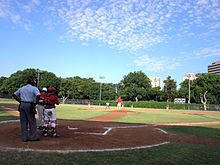 A local league baseball game at Reverchon Park
A local league baseball game at Reverchon Park
The City of Dallas maintains and operates 406 parks on 21,000 acres (85 km2) of parkland. Its flagship park is the 260-acre (1.05 km2) Fair Park, which hosted the Texas Centennial Exposition in 1936. The city is also home to Texas' first and largest zoo, the 95 acres (0.38 km2) Dallas Zoo, which opened at its current location in 1888.[81]
The city's parks contain 17 separate lakes, including White Rock and Bachman lakes, spanning a total of 4,400 acres (17.81 km2). In addition, Dallas is traversed by 61.6 miles (99.1 km) of biking and jogging trails, including the Katy Trail, and is home to 47 community and neighborhood recreation centers, 276 sports fields, 60 swimming pools, 232 playgrounds, 173 basketball courts, 112 volleyball courts, 126 play slabs, 258 neighborhood tennis courts, 258 picnic areas, six 18-hole golf courses, two driving ranges, and 477 athletic fields.[82]
As part of the ongoing Trinity River Project, the Great Trinity Forest, at 6,000 acres (24 km2), is the largest urban hardwood forest in the United States and is part of the largest urban park in the United States.[39] The Trinity River Audubon Center is a new addition to the park. Opened in 2008, it serves as a gateway to many trails and other nature viewing activities in the area. The Trinity River Audubon Center is the first LEED-certified building constructed by the City of Dallas Parks and Recreation Department.
Dallas also hosts three of the 21 preserves of the extensive (3,200-acre/13 km2) Dallas County Preserve System. Both the Joppa Preserve, the McCommas Bluff Preserve the Cedar Ridge Preserve are all within the Dallas city limits. The Cedar Ridge Preserve was formerly known as the Dallas Nature Center, but management was turned over to Audubon Dallas group, which now manages the 633-acre (2.56 km2) natural habitat park on behalf of the City of Dallas and Dallas County. The preserve sits at an elevation of 755 feet (230 m) above sea level, and contains a variety of outdoor activities, including 10 miles (16 km) of hiking trails and picnic areas.
Just southwest of Dallas is Cedar Hill State Park, maintained by the Texas Parks and Wildlife state agency. A 1,826-acre (7.39 km2) urban nature preserve, the park is located on the 7,500-acre (30 km2) Joe Pool Reservoir, and offers activities such as mountain biking, birding, camping and fishing; swimming is allowed at the swimming beach only.[83]
To the west of Dallas in Arlington is Six Flags Over Texas, the original franchise in the Six Flags theme park chain. Hurricane Harbor, a large water park owned by Six Flags, is also in Arlington.
Economy
See also: List of companies in Dallas and List of shopping malls in the Dallas–Fort Worth MetroplexTop publicly traded companies
in Dallas for 2009
(according to revenues)
with Dallas and U.S. ranks.DAL Corporation US 1 AT&T 7 2 Dean Foods 208 3 Texas Instruments 223 4 Southwest Airlines 229 5 Energy Future Holdings Corporation 246 6 Tenet Healthcare 253 7 Affiliated Computer Services 341 8 Energy Transfer Equity 388 9 Celanese 414 10 Atmos Energy 424 11 Holly Corporation 431 12 Blockbuster Inc. 500 Further information:
List of companies in Dallas/Ft.Worth
Source:: Fortune[84]
 The World Headquarters of Texas Instruments in North Dallas.
The World Headquarters of Texas Instruments in North Dallas.
 Comerica Bank Tower, Comerica Bank's national headquarters in Downtown Dallas
Comerica Bank Tower, Comerica Bank's national headquarters in Downtown Dallas
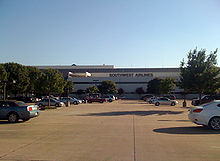 The national headquarters of Southwest Airlines at Dallas Love Field Airport just north of Downtown Dallas.
The national headquarters of Southwest Airlines at Dallas Love Field Airport just north of Downtown Dallas.
In its beginnings, Dallas relied on farming, neighboring Fort Worth's Stockyards, and its prime location on Native American trade routes to sustain itself. Dallas' key to growth came in 1873 with the building of multiple rail lines through the city. As Dallas grew and technology developed, cotton became its boon and by 1900 Dallas was the largest inland cotton market in the world, becoming a leader in cotton gin machinery manufacturing. By the early 1900s Dallas was a hub for economic activity all over the southwestern United States and was selected in 1914 as the seat of the Eleventh Federal Reserve District. By 1925 Texas churned out more than ⅓ of the nation's cotton crop, with 31% of Texas cotton produced within a 100-mile (160 km) radius of Dallas. In the 1930s petroleum was discovered east of Dallas near Kilgore, Texas. Dallas' proximity to the discovery put it immediately at the center of the nation's petroleum market. Petroleum discoveries in the Permian Basin, the Panhandle, the Gulf Coast, and Oklahoma in the following years further solidified Dallas' position as the hub of the market.[85]
The end of World War II left Dallas seeded with a nexus of communications, engineering, and production talent by companies such as Collins Radio Corporation. Decades later, the telecommunications and information revolutions still drive a large portion of the local economy. The city is sometimes referred to as the heart of "Silicon Prairie" because of a high concentration of telecommunications companies in the region, the epicenter of which lies along the Telecom Corridor located in Richardson, a northern suburb of Dallas. The Corridor is home to more than 5,700 companies[86] including Texas Instruments (headquartered in Dallas), Nortel Networks, Alcatel Lucent, AT&T, Ericsson, Fujitsu, Nokia, Rockwell Collins, Cisco Systems, Sprint, Verizon Communications, and until recently[when?] CompUSA (which is now headquartered in Miami,FL).
In the 1980s Dallas was a real estate hotbed, with the increasing metropolitan population bringing with it a demand for new housing and office space. Several of Downtown Dallas' largest buildings are the fruit of this boom, but over-speculation and the savings and loan crisis prevented any further additions to Dallas' skyline. Between the late 1980s and the early 2000s, central Dallas went through a slow period of growth and has only recently recovered. Since 2000, the real estate market in the Dallas-Fort Worth Metroplex has been relatively resilient. However, Dallas is among the largest cities in the U.S. where rent declined significantly. Whereas the national decline in rent is approximately 4%, Dallas rent declined an average of 8% in early 2010. [87]
Texas Instruments, a major manufacturer, employs 10,400 people at its corporate headquarters and chip plants in Dallas. Defense and aircraft manufacturing dominates the economy of nearby Fort Worth.[88][89]
The Dallas-Fort Worth Metroplex has one of the largest concentrations of corporate headquarters for publicly traded companies in the United States. The city of Dallas has 12 Fortune 500 companies,[12] and the DFW region as a whole has 20.[90] In 2007–08, Comerica Bank and AT&T located their headquarters in Dallas. Irving is home to four Fortune 500 companies of its own, including ExxonMobil, the most profitable company in the world and the second largest by revenue for 2008,[91] Kimberly-Clark, Fluor (engineering), and Commercial Metals.[92] Additional companies headquartered in the Metroplex include Southwest Airlines, American Airlines, RadioShack, Neiman Marcus, 7-Eleven, Brinker International, AMS Pictures, id Software, ENSCO Offshore Drilling, Mary Kay Cosmetics, Chuck E. Cheese's, Zales and Fossil. Corporate headquarters in the northern suburb of Plano include HP Enterprise Services, Frito Lay, Dr Pepper Snapple Group, and JCPenney. Many of these companies—and others throughout the DFW metroplex—comprise the Dallas Regional Chamber.
Susan G. Komen for the Cure, the world's largest breast cancer organization[93] was founded and is headquartered in Dallas.
In addition to its large number of businesses, Dallas has more shopping centers per capita than any other city in the United States and is also home to the second shopping center ever built in the United States, Highland Park Village, which opened in 1931.[94] Dallas is home of the two other major malls in North Texas, the Dallas Galleria and NorthPark Center, which is the 2nd largest mall in Texas. Both malls feature high-end stores and are major tourist draws for the region.[citation needed]
According to Forbes Magazine's annual list of "The Richest People in America" published September 21, 2011, the city itself is now home to 17 billionaires, up from 14 in 2009. In 2009 (with 14 billionaires) the city placed 6th worldwide among cities with the most billionaires.[95][96] The ranking does not even take into account the 8 billionaires who live in the neighboring city of Fort Worth.
Dallas is currently the third most popular destination for business travel in the United States, and the Dallas Convention Center is one of the largest and busiest convention centers in the country, at over 1,000,000 square feet (93,000 m2), and the world's single-largest column-free exhibit hall.[97]
Law and government
Main article: Law and government of DallasSee also: List of mayors of Dallas and Sister cities of DallasThe city uses a council-manager government, with Mike Rawlings serving as Mayor, Mary Suhm serving as city manager, and 14 council members serving as representatives to the 14 council districts in the city.[98][99][100] This organizational structure was recently contested by some in favor of a strong-mayor city charter, only to be rejected by Dallas voters.
In the 2006–2007 fiscal year, the city's total budget (the sum of operating and capital budgets) was $2,344,314,114.[101] The city has seen a steady increase in its budget throughout its history due to sustained growth: the budget was $1,717,449,783 in 2002–2003,[102] $1,912,845,956 in 2003–2004,[102] $2,049,685,734 in 2004–2005,[103] and $2,218,345,070 in 2005–2006.[103]
National and state legislators representing Dallas:
The United States District Court for the Northern District of Texas, which exercises original jurisdiction over 100 counties in North and West Texas, convenes in the Earle Cabell Federal Building and Courthouse in the Government District of Downtown. The same building additionally houses United States Bankruptcy and Magistrate Courts and a United States Attorney office. Dallas also is the seat of the Fifth Court of Appeals of Texas.Politics
In terms of voting patterns, the city of Dallas is the most liberal in Texas, according to 2004 Presidential vote totals. This, however, reflects only the urban core; other municipalities in the Dallas-Fort Worth area are very conservative (e.g. Plano, Arlington, and Garland, the third, fourth, and fifth-most conservative cities by the same measure).[105]
As a city, present-day Dallas can be seen as moderate, with conservative Republicans dominating the upper-middle class suburban neighborhoods of North Dallas and liberal Democrats dominating neighborhoods closer to Downtown as well as the city's southern sector. As a continuation of its suburban northern neighborhoods, Dallas' northern parts are overwhelmingly conservative. Plano, the largest of these suburbs, was ranked as the fifth most conservative city in America by the Bay Area Center for Voting Research, based on the voting patterns of middle-age adults. However, the city of Dallas generally votes for Democratic political candidates in local, state, and national elections.[citation needed]
Jim Schutze of the Dallas Observer said in 2002 "the early vote in majority-black precincts in Southern Dallas is the city's only disciplined vote. Especially in citywide elections on issues that are not entwined in the internal politics of the black community, the Southern Dallas African-American vote has a history of responding obediently to the call of leadership."[106]
In the 2004 U.S. Presidential elections, 57% of Dallas voters voted for John Kerry over George W. Bush.[107] Dallas County as a whole was closely divided, with 50% of voters voting for Bush and 49% voting for Kerry.[108] In the 2006 elections for Dallas County judges, 41 out of 42 seats went to Democrats.
In the 2008 elections, both Dallas County and the city of Dallas voted strongly Democratic. In Dallas County as a whole, 58% of voters chose Barack Obama, compared to the 42% who chose John McCain. By an even larger margin, the city of Dallas (not including the small portions of the city located in Collin and Denton Counties) favored Obama over McCain, 65% to 35%. When disregarding the city in Dallas County's results, Obama still defeated McCain by a margin of 0.7% in what was essentially a 50%–50% tie.[109]
In 2004, Lupe Valdez was elected Dallas County Sheriff. An open lesbian, is currently the only female sheriff in the state of Texas. Despite controversies in her handling of county jails, she won re-election in 2008 with a 10-point victory over Republican challenger Lowell Cannaday.[110]
Bucking the city's Democratic trend, conservative Republican Tom Leppert defeated liberal Democrat Ed Oakley in the city's 2007 mayoral race by a margin of 58% to 42%. Though candidates' political leanings are well publicized in the media, Dallas' elections are officially non-partisan. The city's previous mayor was Laura Miller, a liberal Jewish woman who had previously written for the Dallas Observer, the city's most popular alternative newspaper.[citation needed]
Cathie Adams, named chairman in October 2009 of the Republican Party of Texas, is a long-time conservative political activist from Dallas.[citation needed]
Crime and enforcement
Policing in Dallas is provided predominantly by the Dallas Police Department, which has around 3,500 officers.[111] The Dallas chief of police is David Brown (effective May 5, 2010).[112] The Police Headquarters are located in the Cedars neighborhood of South Dallas.
According to the FBI, a city to city comparison of crime rates is not meaningful, because recording practices vary from city to city, citizens report different percentages of crimes from one city to the next, and the actual number of people physically present in a city is unknown.[113] With that in mind, Dallas' violent crime rate (12.06 per 1,000 people) is lower than that of St Louis (24.81), Detroit (24.22), Baltimore (16.96), Philadelphia (15.62), Cleveland (15.47), Miami (15.09), Washington, D.C. (14.48), Kansas City (14.44) and Boston (13.39). However, Houston (11.69), Los Angeles (7.87), and New York City (6.38) have lower violent crime rates than Dallas.[114]
Fire protection
Fire protection and emergency medical service in the city is provided by Dallas Fire-Rescue (DFD), which has 1,670 firefighters and 56 working fire stations in the city limits. All DFD Paramedics are Firefighters, not all Firefighters are EMT-Paramedics but are trained to at least EMT-Basic. EMT-Paramedics and EMT-B's are trained through the University of Texas Southwestern Medical Center at Dallas.[115][116] The department also operates the Dallas Firefighter's Museum at Dallas' oldest remaining fire station, built in 1907, along Parry Avenue near Fair Park. In addition, the department operates in mutual aid agreements with several surrounding municipalities.
In 1995, the Dallas Fire Department Training Academy (now the Chief Dodd Miller Training Academy) began to host firefighter recruits from other Metroplex municipalities in its 22-week basic firefighter training school, effectively becoming a regional training center. The Academy is reverently known as "The Drill Tower" by instructors and graduates, referring to the facility's most taxing structure/activity, a six story tower whose staircase is routinely climbed three times in rapid succession by recruits in full gear and high-rise hose packs. DFD operates 55 Engine Companies, 21 Truck Companies 34 Rescues (M.I.C.U.), 11 Peak Demand Rescues , 10 Battalion Chiefs BC1/Sta4,BC2/07, BC3/8, BC4/28, BC5/25, BC6/14, BC7/35, BC8/34, BC9/47, BC10/39. 2 Division Deputy Chiefs DC806/Sta55 DC807/Sta1. 1 Hazardous Materials Response Team HM03, 2 Hazardous Materials Satellite Team CBRNE40 FA16, 4 ARFF aircraft rescue fire fighting units Sta 21(Love Field)/49Dallas Executive Airport), 9 Booster/brush trucks, 7 Boats quick water rescue response, 1 Marine fire rescue marine boat based at Lake Ray Hubbard, 1 Swift Water Rescue team with a rescue boat unit Sta 34, 2 Urban Search And Rescue USAR Sta 15/19 Heavy Rescue.
Demographics
Main article: Demographics of DallasHistorical populations Census Pop. %± 1860 678 — 1870 3,000 342.5% 1880 10,358 245.3% 1890 38,067 267.5% 1900 42,639 12.0% 1910 92,104 116.0% 1920 158,976 72.6% 1930 260,475 63.8% 1940 294,734 13.2% 1950 434,462 47.4% 1960 679,684 56.4% 1970 844,401 24.2% 1980 904,078 7.1% 1990 1,006,877 11.4% 2000 1,188,580 18.0% 2010 1,197,816 0.8% As of the 2010 Census Dallas had a population of 1,197,816. The median age was 31.8. The racial and ethnic composition of the population was 28.8% non-Hispanic white, 24.6% non-Hispanic black, 0.4% Hispanic black, 0.7% Native American, 2.9% Asian (0.6% Indian, 0.5% Chinese, 0.5% Vietnamese, 0.3% Korean, 0.2% Burmese, 0.2% Filipino), 0.2% non-Hispanic from some other race, 2.6% from two or more races and 42.4% Hispanic or Latino. Among the Hispanic population, 36.7% of Dallas is Mexican, 1.3% Salvadoran, 0.6% Honduran, 0.4% Guatemalan, and 0.3% Puerto Rican.[117][118]
U.S. Census estimates released in 2008 indicated that there were 1,279,910 people living in Dallas proper. According to Census data compiled between 2005 and 2007, there were 440,633 households and 257,339 families residing in the city. The population density was 3,623 people per square mile (1,398.8/km²). There were 510,591 housing units at an average density of 1,491.2 per square mile (575.8/km²).[119]
There were 440,633 households out of which 30.3% had children under the age of 18 living with them, 37.2% were married couples living together, 15.2% had a female householder with no husband present, and 41.6% are classified as non-families by the United States Census Bureau. 34.4% of all households had one or more people under 18 years of age, and 16.4% had one or more people who was 65 years of age or older. The average household size was 2.65 and the average family size was 3.52.[120]
In the city the age distribution of the population shows 26.6% under the age of 18 and 8.5% who were 65 years of age or older. The median age was 32.1 years. 51.4% of the population was male and 48.6% was female.[121]
The median income for a household in the city was $40,147, and the median income for a family was $42,670. Male full-time workers had a median income of $32,265 versus $32,402 for female full-time workers. The per capita income for the city was $25,904. About 18.7% of families and 21.7% of the population were below the poverty line, including 33.6% of those under age 18 and 13.4% of those aged 65 or over.[122] The median price for a house was $128,200.[119]
According to the 2006–2008 American Community Survey, [123] the racial composition of the city was 56.6% White (Non-Hispanic Whites: 30.1%), 23.2% Black or African American, 0.4% American Indian, 2.5% Asian, 0.1% Native Hawaiian and Other Pacific Islander, 15.9% from some other race, and 1.3% from two or more races. Hispanics or Latinos (of any race) make up 43.1% of the total population; Mexican Americans make up 38.5% of the population.
Dallas' population has historically been predominantly white, but its population has diversified as it has grown in size and importance over the 20th century to the point that non-Hispanic whites now represent less than one-third of the city's population.[124] In addition, recent data showed that 26.5% of Dallas' population and 17% of residents in the Metroplex as a whole were foreign-born.[120][125]
Dallas is a major destination for Mexican immigrants, both legally and illegally. The southwestern and southeastern portions of the city, particularly Oak Cliff and Pleasant Grove, are chiefly inhabited by black and Hispanic residents, while the southern portion of the city is predominantly black. The West and East sides of the city are predominately Hispanic. North Dallas, on the other hand, is mostly white, though many enclaves of predominantly black and Hispanic residents exist. In addition, Dallas and its suburbs are home to a large number of Asian residents—Koreans, Taiwanese, Chinese, Filipinos, Vietnamese, Indians, Bangladeshis, Pakistanis, Sri Lankans, Nepalese, and Arabs all have large presences in the area, particularly in the suburbs of Garland, Richardson, Plano, Carrollton, Irving, Frisco, Flower Mound, and Allen.[citation needed]
About half of Dallas's population was born outside of Texas. Many residents have migrated to the city from other parts of the country, particularly the Midwest, Northeast, and California.[126]
Education
Main article: Education in DallasThere are 337 public schools, 89 private schools, 38 colleges, and 32 libraries in Dallas.[127]
Colleges and universities
Further information: List of Dallas-Fort Worth area colleges and universitiesDallas is a center of education for much of the south central United States. In addition to those located in the city, the surrounding area also contains a number of universities, colleges, trade schools, and other educational institutions. The following describes the various universities and their proximity to the city:
Colleges and universities in the Dallas city limits
- The University of Texas Southwestern Medical School is a medical school located in the city's Stemmons Corridor. It is part of the University of Texas Southwestern Medical Center at Dallas, one of the largest grouping of medical facilities in the world. The school is very selective, admitting only around 200 students a year. The facility enrolls 3,255 postgraduates and is home to four Nobel Laureates—three in physiology/medicine and one in chemistry. UTSW is part of the University of Texas System.
- Texas Woman's University (TWU) has two branches of their university located in Dallas. There is a campus located near Parkland hospital that specializes in nursing. There is also a campus near Presbyterian hospital that specializes in occupational therapy and physical therapy.
- Paul Quinn College is a private, historically black college located in southeast Dallas. Originally located in Waco, Texas, it moved to Dallas in 1993 and is housed on the campus of the former Bishop College, another private, historically black college. Dallas billionaire and entrepreneur Comer Cottrell, Jr., founder of ProLine Corporation, bought the campus of Bishop College and bequeathed it to Paul Quinn College in 1993.[128] The school enrolls about 3,000 undergraduate students.
- The University of North Texas at Dallas, located along Houston School Road.[129] In 2009 UNT at Dallas became the first public university within Dallas city limits.[38] The University of North Texas System has requested approval from the Texas Legislature and Texas Higher Education Coordinating Board for the State's first new public law school in more than 40 years. Plans are for the UNT College of Law to be based at the Old Municipal Building in downtown Dallas.[130]
- Dallas Theological Seminary, also within the city limits, is recognized as one of the leading seminaries in the evangelical faith. Situated 3 miles (5 km) east of Downtown Dallas, it currently enrolls over 2,000 graduate students and has graduated over 12,000 alumni.
- Dallas Baptist University (DBU) is a private, coeducational university located in the Mountain Creek area of southwest Dallas. Originally located in Decatur, Texas, the school moved to Dallas in 1965.[131] The school currently enrolls over 5,100 students,[132] and offers undergraduate, graduate, and doctoral degrees. Popular subjects include Biblical studies, business, and music degrees. The school also maintains an Intensive English Program for international students wishing to enhance their knowledge of the English language. The school has also become nationally recognized in the past few years for its baseball team which has made several playoff runs.
- Criswell College, (within two blocks of Dallas Theological Seminary). Criswell was started by First Baptist Church of Dallas in the early 1970s. It presently has around 400 students at both the undergraduate and graduate level studying different Biblical and Christian subjects.
- Dallas County Community College District, the 2-year educational institution of Dallas County; it has seven campuses located throughout the area with branches in Dallas as well as the surrounding suburbs. DCCCD serves portions of Dallas in Dallas County.
Collin College serves portions of Dallas in Collin County.
Colleges and universities near Dallas
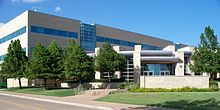 Engineering and Computer Science Complex at University of Texas at Dallas
Engineering and Computer Science Complex at University of Texas at Dallas
- Southern Methodist University (SMU) is a private, coeducational university in University Park, an independent city that, together with the adjacent town of Highland Park, is entirely surrounded by Dallas. SMU was founded in 1911 by the Southern Methodist Church and now enrolls 6,500 undergraduates, 1,200 professional students in the law and theology departments, and 3,500 postgraduates.[133][134] According to sources such as the U.S. News & World Report, SMU is the best overall undergraduate college in the Dallas-Fort Worth Metroplex and the third best in the State of Texas.
- The University of Texas at Dallas (UTD), also part of the state public University of Texas System, is located in the city of Richardson, is adjacent to Dallas' Far North Dallas neighborhood, and is in the heart of the Telecom Corridor. UT Dallas, or UTD, is renowned for its work in combining the arts and technology, as well as for its programs in engineering, computer science, economics, international political economy, neuroscience, speech and hearing, pre-health, pre-law and management. The university has many collaborative research relationships with UT Southwestern Medical Center. UT Dallas is home to approximately 17,000 students.
- The University of Dallas (UD), in the suburb of Irving, is an enclave of traditional Roman Catholicism in the mostly Protestant religious landscape of Dallas. St. Albert the Great Dominican Priory and Holy Trinity Seminary are located on campus, while the Cistercian Monastery and Cistercian Preparatory School are located just to the north of the UD campus across Texas State Highway 114. The Highlands School, a PK–12 Legionary school, is just to the west of the UD campus and is connected to campus by jogging trails. As a center for religious study, the Cistercian Monastery continues to be notable in scholastic developments in theology.
University Research Center
Other area colleges and universities
Also in the nearby suburbs and neighboring cities are:
- Collin College in Collin County.
- Remington College in Garland, Texas, established in July 1997.
- Remington College (Ft. Worth Campus)
- The University of North Texas (UNT) in Denton
- Texas Woman's University (TWU) also in Denton.
- The University of Texas at Arlington (UTA).
- University of Phoenix, Dallas Campus in Dallas, Irving, Plano, Arlington, Hurst, and Cedar Hill.
- Dallas Christian College (DCC) in Farmers Branch.
Also, within the Dallas/Fort Worth area, about 30 miles (48 km) to the west of the city of Dallas, Fort Worth has two major universities within its city limits,and one health sciences/medical school:
- Texas Christian University (TCU)
- Texas Wesleyan University.
- University of North Texas Health Science Center at Fort Worth
A number of colleges and universities are also located outside the immediate metropolitan area, including:
- Austin College in nearby Sherman.
- Texas A&M University–Commerce
- Navarro College in nearby Corsicana
- Tarrant County College in Tarrant County.
Primary and secondary schools
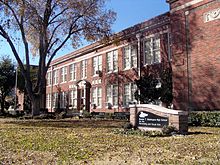 Booker T. Washington High School for the Performing and Visual Arts (Dallas ISD) in the Arts District
Booker T. Washington High School for the Performing and Visual Arts (Dallas ISD) in the Arts District
Most neighborhoods in the city of Dallas are located within the Dallas Independent School District, the 12th-largest school district in the United States.[136] The school district operates independently of the city and enrolls over 161,000 students.[136] In 2006, one of the district's magnet schools, The School for the Talented and Gifted in Oak Cliff, was named the best school in the United States (among public schools) by Newsweek, retaining the title in 2007 and regaining the top spot in 2009. Another one of DISD's schools, the Science and Engineering Magnet, placed 8th in the same 2006 survey and moved up to the No. 2 spot the following year.[137] Other DISD high schools named to the list were Hillcrest, W. T. White, Williams Preparatory, and Woodrow Wilson high schools. Woodrow Wilson was also named the top comprehensive high school in Dallas by local publication D Magazine.
A few areas of Dallas also extend into other school districts, including Carrollton-Farmers Branch, Duncanville, Garland,[138] Highland Park, Mesquite, Plano, and Richardson. The Wilmer-Hutchins Independent School District once served portions of southern Dallas, but it was shut down for the 2005–2006 year. WHISD students started attending other Dallas ISD schools during that time. Following the close, the Texas Education Agency consolidated WHISD into Dallas ISD.
Many school districts in Dallas County, including Dallas ISD, are served by a governmental agency called Dallas County Schools. The system provides busing and other transportation services, access to a massive media library, technology services, strong ties to local organizations for education/community integration, and staff development programs.[139]
Private schools
There are also many private schools in Dallas, such as St. Elizabeth of Hungary Catholic School St. Mark's School of Texas, The Hockaday School, Greenhill School, Burton Adventist Academy, Ursuline Academy of Dallas, Jesuit College Preparatory School of Dallas, June Shelton School, Lakehill Preparatory School, Episcopal School of Dallas, The Lamplighter School, Parish Episcopal School, Bishop Dunne Catholic School, Bishop Lynch High School, Yavneh Academy of Dallas, Dallas Lutheran School, The Winston School, Dallas Christian School on the borders of Mesquite and Garland, First Baptist Academy of Dallas, and Tyler Street Christian Academy in Oak Cliff. Some Dallas residents attend Cistercian Preparatory School in adjacent Irving, The Highlands School in Irving, and Trinity Christian Academy in Addison.
Libraries
The city is served by the Dallas Public Library system. The system was originally created by the Dallas Federation of Women's Clubs with efforts spearheaded by then-president Mrs. Henry (May Dickson) Exall. Her work in raising money led to a grant from philanthropist and steel baron Andrew Carnegie, which enabled the construction of the first branch of the library system in 1901.[140] Today, the library operates 27 branch locations throughout the city, including the 8-story J. Erik Jonsson Central Library in the Government District of Downtown.[141]
The former Texas School Book Depository, where according to the Warren Commission Report, Lee Harvey Oswald shot and killed president John F. Kennedy in 1963, has served since the 1980s as a county government office building, except for its sixth and seventh floors, which house the "museum of the assassination", known officially as The Sixth Floor Museum.
Infrastructure
Health systems


Panorama of the Dallas Medical District with UT Southwestern Medical Center Dallas has many hospitals and a number of medical research facilities within its city limits. One major research center is the Dallas Medical District with the UT Southwestern Medical Center in the Stemmons Corridor, along with the affiliated UT Southwestern Medical School. The health care complex includes within its bounds Parkland Memorial Hospital, Children's Medical Center, St. Paul University Hospital, and the Zale Lipshy University Hospital.
Dallas also has a VA hospital in the southern portion of the city, the Dallas Veterans Affairs Medical Center. The center is home to a Consolidated Mail Outpatient Pharmacy (CMOP), part of an initiative by the Department of Veterans Affairs to provide mail-order prescriptions to veterans using computerization at strategic locations throughout the United States.
U.S. News and World Report, in their 2004 edition on "America's Best Hospitals", Parkland Memorial Hospital had one of the nation's best overall ratings. Also the specialties at Parkland Memorial Hospital were rated among the best in the nation, in 7 different categories. Those categories (and the ratings) were: Rheumatology- 23rd nationally; Orthopedics- 20th nationally; Kidney Disease- 17th nationally; Hormonal Disorders- 14th nationally; Heart and Heart Surgery- 18th nationally; Gynecology- 11th nationally; Ear, Nose, and Throat- 47th nationally.
Parkland Memorial Hospital is named one of Modern Healthcare's "25 busiest community hospital emergency departments". Parkland is a 2006 Professional Research Consultants Excellence in Healthcare award winner for Patient Perception and Overall Quality of Care.[142]
Other hospitals in the city include Baylor University Medical Center in East Dallas, Methodist Dallas Medical Center in Oak Cliff, Methodist Charlton Medical Center near Duncanville, Medical City Dallas Hospital and Presbyterian Hospital in North Dallas, and the Texas Scottish Rite Hospital for Children in Oak Lawn.
Transportation
Main article: Transportation in DallasLike many other major cities in the United States, the primary mode of local transportation in Dallas is the automobile, though efforts have been made to increase the availability of alternative modes of transportation, including the construction of light rail lines, biking and walking paths, wide sidewalks, a trolley system, and buses. A 2011 study by Walk Score ranked Dallas the thirtieth most walkable of fifty largest cities in the United States.[143]
Highways
 North Central Expressway (US 75) southbound towards downtown Dallas
North Central Expressway (US 75) southbound towards downtown Dallas
The city is at the confluence of four major interstate highways—Interstates 20, 30, 35E, and 45. The Dallas area freeway system is set up in the popular hub-and-spoke system, shaped much like a wagon wheel. Starting from the center of the city, a small freeway loop surrounds Downtown, followed by the Interstate 635 loop about 10 miles (16 km) outside Downtown, and ultimately the tolled President George Bush Turnpike. Inside these freeway loops are other boulevard- and parkway-style loops, including Loop 12 and Belt Line Road. Another beltway around the city upwards of 45 miles (72 km) from Downtown is under plan in Collin County.
Radiating out of Downtown Dallas' freeway loop are the spokes of the area's highway system—Interstates 30, 35E, and 45, U.S. Highway 75, U.S. Highway 175, State Spur 366, the Dallas North Tollway, State Highway 114, U.S. Highway 80, and U.S. Highway 67. Other major highways around the city include State Highway 183 and State Spur 408. The recently completed interchange at the intersection of Lyndon B. Johnson Freeway (Interstate 635) and Central Expressway (U.S. Highway 75) contains 5 stacks and is aptly called the High Five Interchange. It is currently one of the few 5-level interchange in Dallas and is one of the largest freeway interchanges in the United States.
The following is a list of the freeways and tollways in the Dallas/Ft. Worth area:
 Interstate 20
Interstate 20 Interstate 30
Interstate 30 Interstate 35E
Interstate 35E Interstate 35W
Interstate 35W Interstate 45
Interstate 45 Interstate 635
Interstate 635 Interstate 820
Interstate 820 U.S. Highway 67
U.S. Highway 67 U.S. Highway 75
U.S. Highway 75 U.S. Highway 80
U.S. Highway 80 U.S. Highway 175
U.S. Highway 175 U.S. Highway 287
U.S. Highway 287 State Highway 114
State Highway 114
 State Highway 121
State Highway 121 State Highway 161
State Highway 161 State Highway 183
State Highway 183 State Highway 190
State Highway 190 State Highway 360
State Highway 360 Loop 12
Loop 12 Spur 366
Spur 366 Spur 408
Spur 408 Dallas North Tollway
Dallas North Tollway- President George Bush Turnpike
- Sam Rayburn Tollway
Transit systems
Dallas Area Rapid Transit (DART) is the Dallas-area public transportation authority, providing rail, buses and HOV lanes to commuters. DART began operating the first light rail system in the Southwest United States in 1996 and is now the largest operator of light rail in the US.[144] Today, the system is the seventh-busiest light rail system in the country with approximately 55 stations on 72 miles of light rail, and 10 stations on 35 miles of commuter rail.[145] Four light rail lines and a commuter line are currently in service: the Red Line, the Blue Line, the Green Line, the Orange Line (peak-service only), and the Trinity Railway Express.
The Red Line travels through Oak Cliff, South Dallas, Downtown, Uptown, North Dallas, Richardson and Plano, while the Blue Line goes through Oak Cliff, Downtown, Uptown, East Dallas, Lake Highlands, and Garland. The Red and Blue lines are conjoined between 8th & Corinth Station in Oak Cliff through Mockingbird Station in North Dallas. The two lines service Cityplace Station, the only subway station in the Southwest. The Green Line serves Carrollton, Farmers Branch, Love Field Airport, Stemmons Corridor, Victory Park, Downtown, Deep Ellum, Fair Park, South Dallas, and Pleasant Grove. The Orange Line operates as a peak-service line providing extra capacity on portions of the Green and Red Lines (Bachman Station on the Green Line, through the Downtown transit mall, to Parker Road Station on the Red Line making a "U"-shape). The Orange Line rush-hour service will become part of regular service on opening of the first segment of the Orange Line towards Dallas-Fort Worth International Airport in 2012.[146]
DART is continuing construction on its Orange and Blue lines. The Orange Line is being extended by roughly 14 miles and will serve DFW Airport, Irving, and Las Colinas, once completed, along with its current services.[147] The Orange Line will open in two phases beginning in 2012. The first phase, Bachman Station to Belt Line Station, will open in December 2012. The second and final phase will open in December 2014 and will provide DFW Airport with rail service. DFW Airport Station will be the terminus for the Orange Line and will connect to Skylink.[147] This will provide passengers the convenience of disembarking the DART rail, proceeding to security check-in and immediately boarding Skylink to be quickly transported to their desired terminal. The Blue Line is being extended by 4.5 miles to serve Rowlett at the current Rowlett Park & Ride facility.[148]
In August 2009, The Regional Transportation Council agreed to seek $96 million in federal stimulus dollars for a trolley project in Dallas and Fort Worth. The Oak Cliff Transit Authority took the lead with leaders envisioning a streetcar line that would link Union Station and the Dallas Convention Center in downtown to Oak Cliff, Methodist Medical Center, and the Bishop Arts District via the Houston Street Viaduct.[149] Dallas was awarded a $23 million TIGER grant towards the $58 million Dallas Streetcar Project in February 2010.[150] The Dallas Streetcar Project will link up with the current McKinney Avenue Transit Authority (MATA) trolley line (also known as the M-Line) in Uptown with a new alignment on Olive Street.
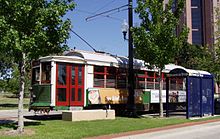 M-Line Trolley at Cityplace Station
M-Line Trolley at Cityplace Station
In addition to light rail, Amtrak's Texas Eagle also serves Union Station, providing long-distance train service to Chicago, San Antonio and Los Angeles once daily. The Trinity Rail Express terminates at Union Station and T&P Station.
Air
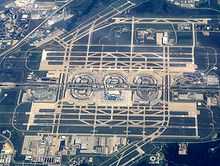 Dallas/Fort Worth International Airport serves most passengers flying in and out of the Metroplex
Dallas/Fort Worth International Airport serves most passengers flying in and out of the Metroplex
Dallas is served by two commercial airports: Dallas/Fort Worth International Airport (DFW) and Dallas Love Field (DAL). In addition, Dallas Executive Airport (formerly Redbird Airport), serves as a general aviation airport for the city, and Addison Airport functions similarly just outside the city limits in the suburb of Addison. Two more general aviation airports are located about 35 miles (56 km) north of Dallas in McKinney, and another two are located in Fort Worth, on the west side of the Metroplex.
DFW International Airport is located in the suburbs slightly north of and equidistant to Downtown Fort Worth and Downtown Dallas. In terms of size, DFW is the largest airport in the state, the 4th largest in the United States, and 6th largest in the world; DFW International Airport is larger than the island of Manhattan. In terms of traffic, DFW is the busiest airport in the state, 5th busiest in the United States, and 6th busiest in the world. The headquarters of American Airlines, the 3rd largest air carrier in the world behind United Airlines and Delta Air Lines, is located less than a mile from DFW within the city limits of Fort Worth. Similarly, Love Field is located within the city limits of Dallas about 6 miles (10 km) northwest of Downtown, and is headquarters to Southwest Airlines.
Utilities
Dallas is served by Dallas Water Utilities, which operates several waste treatment plants and pulls water from several area reservoirs.[151] The city's electric system is maintained by several companies, including Cirro Energy and TXU,[152] whose parent company, Energy Future Holdings Corporation, has headquarters in the city.[153] The city offers garbage pickup and recycling service weekly through its Sanitation Services department.[154] Telephone networks, broadband internet, and cable television service are available from several companies, including AT&T, Time Warner Cable, and Verizon FiOS.
Places of interest
- University of Texas at Dallas
- Cotton Bowl
- Dallas Museum of Art
- The Sixth Floor Museum
- Texas Schoolbook Depository
- Morton H. Meyerson Symphony Center
- Southern Methodist University
- Fair Park
- Dallas World Aquarium
- Victory Park
- Reunion Tower
- Margaret Hunt Hill Bridge
- Pizza Hut Park
Notable people
- Selena Gomez, Singer, Actress, Humanitarian, known for her work with Disney, grew up in neighboring town Grand Prairie, Selena Gomez has performed multiple times at the Gexa Energy Theater in Fair Park, and is notably her favorite place to perform primarily being so close to home.
- Stanley Marcus founder of *Neiman- Marcus
- Stevie Ray Vaughan, American blues guitarist
- Ashlee Simpson and *Jessica Simpson American singers and actresses
- Demi Lovato, singer-songwriter, actress, musician, known for her TV series Sonny With A Chance , Camp Rock movies. She performed in Dallas few times because Dallas is "one of my favourite places on Earth. That's where I'm from."
- Ross Perot American billionaire businessman
- Nick Jonas, Pop-singer best know for his appearances on various Disney Channel television shows and the Jonas Brothers Band
- Allen R. Morris – Emmy Award winning producer/director/writer
- Usher American singer currently holding the title of * King of R&B
- Jake Pavelka, reality TV personality, best known for being The Bachelor and his appearances on The Bachelorette and Bachelor Pad
- Mitchell Musso, Singer, and Actor, known best for his role on Hannah Montana
- Leighton Meester American actress and singer know for her appearance on * Gossip Girl
- Aaron Spelling,mulit-billion dollar television and film producer
- Jensen Ackles, Actor known for playing Dean Winchester on Supernatural (TV Series).
- Lance Armstrong, Professional road racing cyclist who won the Tour de France seven consecutive times
- Jason Castro, Christian pop artist who appeared on the seventh season of American Idol
- Dorothy Malone, Oscar Winning Actress 1957 "Written On The Wind"
- The D.O.C., Rapper,songwriter and vocalis, best known for his work with Death Row Records.
- George W. Bush and *Laura Bush 43rd American President and his wife
- Vanilla Ice, Rapper, know for his "Ice, Ice, Baby" song
- Owen Wilson and * Luke Wilson are American actors
- Chris Young baseball player associated with the Texas Rangers
Sister cities
Dallas has six Sister cities and five Friendship cities.[155]
Sister cities
 Brno, Czech Republic
Brno, Czech Republic Dijon, France
Dijon, France Monterrey, Mexico
Monterrey, Mexico Riga, Latvia
Riga, Latvia Saratov, Russia
Saratov, Russia Taipei, Taiwan
Taipei, Taiwan Ipoh, Malaysia
Ipoh, Malaysia
Friendship cities
 Sendai, Japan
Sendai, Japan Tianjin, People's Republic of China
Tianjin, People's Republic of China Qingdao, People's Republic of China
Qingdao, People's Republic of China Dalian, People's Republic of China
Dalian, People's Republic of China Nanjing, People's Republic of China
Nanjing, People's Republic of China
See also
- Dallas (TV series)
- I-35 Corridor
- John F. Kennedy assassination
- List of people from Dallas
- National Register of Historic Places listings in Dallas County, Texas
- Texaplex
- Texas Triangle
References
- ^ U.S. Census Bureau, Population Division (February 17, 2010). "Population Estimates, Accepted Challenges to Vintage 2007 Estimates". http://www.news-journal.com/news/article_d1b2e9d2-3ad4-11e0-b390-001cc4c002e0.html. Retrieved February 17, 2010.[dead link]
- ^ "American FactFinder". United States Census Bureau. http://factfinder.census.gov. Retrieved 2008-01-31.
- ^ "US Board on Geographic Names". United States Geological Survey. 2007-10-25. http://geonames.usgs.gov. Retrieved 2008-01-31.
- ^ Texas Almanac | TexasAlmanac.com | Texas State Historical Association | Facts, Profile & Rank
- ^ City Mayors: Largest 100 US cities
- ^ U.S. Census Bureau table of metropolitan statistical areas
- ^ Wikipedia article on metropolitan statistical areas Table of United States Metropolitan Statistical Areas#cite note-PopEstCBSA-2
- ^ "Census: DFW adds more than 146,000 people". http://economywatchblog.dallasnews.com/archives/2010/03/dfw-area-adds-more-than-146000.html. Retrieved May 1, 2010.
- ^ List of United States cities by population. http://en.wikipedia.org/wiki/List_of_United_States_cities_by_population.
- ^ U.S. Census Bureau, Population Division (March 19, 2010). "Table 1. Annual Estimates of the Population of Metropolitan and Micropolitan Statistical Areas: April 1, 2000 to July 1, 2009 (CBSA-EST2009-01)" (CSV). 2009 Population Estimates. United States Census Bureau. http://www.census.gov/popest/metro/tables/2009/CBSA-EST2009-01.csv. Retrieved May 1, 2010.
- ^ "Gross Metropolitan Product". Greyhill Advisors. http://greyhill.com/gross-metropolitan-product/. Retrieved 7 October 2011.
- ^ a b Fortune 500: Cities with 5 or more FORTUNE 500 headquarters (2010) – Retrieved on May 18, 2010
- ^ side note: In ascending order from the Dallas/Fort Worth Metroplex (in terms of metropolitan population): Chicago via Lake Michigan, Los Angeles via the Pacific Ocean, and New York City via the Atlantic Ocean.
- ^ Jackie McElhaney and Michael V. Hazel: DALLAS, TX from the Handbook of Texas Online. Retrieved April 20, 2006.
- ^ Globalization and World Cities Research Network, Loughborough University. "GaWC – The World According to GaWC 2010". http://www.lboro.ac.uk/gawc/world2010t.html. Retrieved September 14, 2011.
- ^ Bolton, Herbert E. (1914). Athanase de Mezieres and the Louisiana-Texas Frontier 1768–1780. Cleveland: Arthur H Clark Company.
- ^ Joseph Milton Nance: Republic of Texas from the Handbook of Texas Online. Retrieved September 25, 2006.
- ^ John N. Furlong; Greg Ajemian and Ms. Tommie McPherson (2003). "History of the Dallas Floodway" (PDF). http://www.trinityrivercorridor.org/pdf/DallasFloodwayHistoryPaper.pdf. Retrieved August 5, 2009.
- ^ "Disvover The Trinity-Dallas". Discover The Trinity. Discoverthetrinity.org. http://www.discoverthetrinity.org/. Retrieved September 12, 2009.
- ^ Trinity River Corridor Project Management Office. "Trinity River Corridor Project Frequently Asked Questions". http://www.trinityrivercorridor.org/html/faqs.html. Retrieved October 19, 2006.
- ^ Bobby Farquhar and Mark McDonald. "Lake Ray Hubbard". Set the Hook Guide to Lone Star Lakes and Lunkers. http://www.rtis.com/reg/lakes/rayhubba.htm. Retrieved August 5, 2009.
- ^ "NAS Dallas / Hensley Field". GlobalSecurity.org. http://www.globalsecurity.org/military/facility/dallas.htm. Retrieved August 5, 2009.
- ^ Aasen, Eric (May 18, 2005). "Foes say North Lake development a threat to lifestyle". Dallas Morning News (Coppell)
- ^ DFW Climate[dead link]. Retrieved on March 26, 2006.
- ^ DFW – Annual 32 Degree Occurrences[dead link]. Retrieved on January 28, 2009.
- ^ TXDOT – Wildflower and Fall Foliage. Retrieved on April 17, 2007.
- ^ "Texas USDA Hardiness Zone Map". http://www.plantmaps.com/interactive-texas-usda-plant-zone-hardiness-map.php. Retrieved November 28, 2010.
- ^ USNA – USDA Plant Hardiness Zone Map: South-Midwest US. Retrieved on June 13, 2006.
- ^ Lungusa.com[dead link]. Retrieved on March 2, 2006.
- ^ Downwindersatrisk.org – Pollution in Midlothian[dead link]. Retrieved on April 17, 2006.
- ^ a b "Dallas/Fort Worth – Normal, Means, and Extremes". National Weather Service Fort Worth. http://www.srh.noaa.gov/fwd/?n=dfwann. Retrieved April 17, 2010.
- ^ "Historical Weather for Dallas, Texas, United States". http://www.weatherbase.com/weather/weatherall.php3?s=95227&refer=&units=us.
- ^ "Climatological Normals of Dallas". Hong Kong Observatory. http://www.hko.gov.hk/wxinfo/climat/world/eng/n_america/us/dallas_e.htm. Retrieved 2010-05-12.
- ^ Swissavenue.com[dead link] – Retrieved June 13, 2006. Archived February 7, 2006 at the Wayback Machine
- ^ Lake Highlands Area Improvement Association – Map[dead link]. Retrieved October 3, 2006.
- ^ Oak Cliff, Texas – Early History. Retrieved August 1, 2008.
- ^ Dallas Morning News – "Dallas at the Tipping Point[dead link]" – Costs of Crime[dead link]. Retrieved October 25, 2006.
- ^ a b University of North Texas Dallas Campus – Location. Retrieved October 4, 2006.
- ^ a b "The Great Trinity Forest-Dallas". The Great Trinity Forest. City of Dallas Trinity River Corridor Project. http://www.trinityrivercorridor.org/html/great_trinity_forest.html. Retrieved September 12, 2009.
- ^ Nelson, Colleen McCain (October 5, 2005). "One Man's Invention, Forever Frozen In Time – Dallas: Margarita Machine Takes Its Rightful Place In History". Dallas Morning News. http://www.dallasnews.com/s/dws/news/city/lakewood/stories/DN-margarita_09met.ART.West.Edition2.4242abd.html. Retrieved February 7, 2007.[dead link]
- ^ "USDA top 10 Steak Houses in America". Primesteakhouses.com. http://www.primesteakhouses.com/. Retrieved August 14, 2010.
- ^ The Dallas Opera – The Winspear Opera House[dead link]. Retrieved on October 19, 2006.
- ^ Dallas Center for the Performing Arts – Building the Center[dead link]. Retrieved on October 19, 2006.
- ^ Artsmagnet.org. Retrieved on April 20, 2006.
- ^ Payne, Darwin (1982). "Chapter VI: The Spirit of Enterprise". Dallas, an illustrated history. Woodland Hills, California: Windsor Publications. pp. 157–185. ISBN 0-89781-034-1.
- ^ The Deep Ellum Association – Time Line[dead link]. Retrieved on October 19, 2006.
- ^ Southside on Lamar – History[dead link]. Retrieved on October 19, 2006.
- ^ Gilley's Dallas – "The Legend Returns: Gilley's Brings New Life to Downtown Dallas[dead link]." (PDF). Retrieved on October 19, 2006.
- ^ Poor David's Pub – Find Us. Retrieved on October 19, 2006.
- ^ The Dallas Morning News – September 6, 2005. Mark Cuban snaps up tracts near downtown[dead link] by Steve Brown. Retrieved on April 20, 2006.
- ^ Bishop Arts District – Information from home page. Retrieved on October 19, 2006.
- ^ City of Dallas Office of Cultural Affairs – Cultural Centers. Retrieved on October 19, 2006.
- ^ Arbitron – Fall 2006 Market Ratings. Retrieved on October 13, 2006.
- ^ Radio-Locator – Dallas, Texas. Retrieved on October 20, 2006.
- ^ Dallas' Fair Park Newsletter. Retrieved on May 9, 2006.
- ^ WRR Classical 101.1 FM: The First Radio Station In Texas, est. 1921 – About WRR[dead link]. Retrieved on May 9, 2006.
- ^ Emailwire.com – "Hispanic Broadcasting Corporation Announces Renan Almendarez Coello, El Cucuy De La Mañana, “is Taking His Career to New Heights”[dead link]." Originally published January 30, 2003. Retrieved on October 19, 2006.
- ^ Business.com – Hispanic Broadcasting Corporation[dead link]. Retrieved on October 19, 2006.
- ^ SuperPages – Orthodox churches in Dallas, Texas. Retrieved on October 13, 2006.
- ^ Select Location
- ^ Dallas Texas LDS (Mormon) Temple
- ^ "Sikh Temple of North Texas". Sikhtempledallas.org. http://www.sikhtempledallas.org/. Retrieved May 23, 2010.
- ^ "Gurdwara Singh Sabha of North Texas, Richardson". Gurdwararichardson.org. http://www.gurdwararichardson.org/. Retrieved May 23, 2010.
- ^ "Sikh Gurdwaras in USA – Sikh Gurdwara in USA". Gurdwara.us. http://www.gurdwara.us/south.html. Retrieved May 23, 2010.
- ^ "Dallas solstice celebration fills a void for the nonreligious". http://www.dallasnews.com/sharedcontent/dws/news/localnews/stories/DN-solstice_21met.ART0.North.Edition1.37a06fc.html. Retrieved December 21, 2007.[dead link]
- ^ FC Dallas – About[dead link]. Although FC Dallas has not yet won a MLS Cup, they won the Lamar Hunt U.S. Open Cup in 1997. Retrieved on October 20, 2006.
- ^ Dallas Sidekicks – Turf Time[dead link]. Retrieved on October 20, 2006.
- ^ Texas Tornado – Information from home page. Retrieved on October 20, 2006.
- ^ [1] – [2]. Retrieved on May 24, 2008.
- ^ "#1 Manchester United". Forbes. June 30, 2007. http://www.forbes.com/lists/2008/34/biz_soccer08_Manchester-United_340001.html. Retrieved May 23, 2010.
- ^ Dallas Cowboys[dead link] – History[dead link]. Retrieved on October 20, 2006.
- ^ Rangers Ballpark. Retrieved on August 1, 2008.
- ^ 2010/2011 ALCS Champion
- ^ Texas Rangers – Ballpark. Retrieved on October 20, 2006.
- ^ "Rugby Football Union". Texasrugbyunion.com. http://www.texasrugbyunion.com/. Retrieved August 14, 2010.
- ^ USA Super League Website
- ^ Harlequins Official Website
- ^ Dallas Diamonds – Information from home page. Retrieved on October 20, 2006.
- ^ Dallas Diamonds – Stadium. Retrieved on October 20, 2006.
- ^ Dallas Revolution – Information from home page. Retrieved on October 20, 2006.
- ^ DallasZoo.com – General Information[dead link]. Retrieved on September 28, 2006.
- ^ DallasParks.org – Facilities. Retrieved on September 28, 2006.
- ^ "Texas Parks and Wildlife online". Tpwd.state.tx.us. December 4, 2009. http://www.tpwd.state.tx.us/spdest/findadest/parks/cedar_hill/. Retrieved August 14, 2010.
- ^ Fortune 500: Texas Companies 2010 – Retrieved on May 18, 2010
- ^ Payne, Darwin (1982). "Chapter VII: The Emergence of "Big D"". Dallas, an illustrated history. Woodland Hills, California: Windsor Publications. pp. 189–221. ISBN 0-89781-034-1.
- ^ Telecom Corridor website. Retrieved February 21, 2006.
- ^ "Dallas News: Dallas Rents Dives". http://economywatchblog.dallasnews.com/archives/2010/02/dallas-apartment-rents-dive.html. Retrieved October 28, 2010.
- ^ Dallas-Fort Worth Ozone Nonattainment Area[dead link]. Retrieved October 1, 2006. Archived July 21, 2006 at the Wayback Machine[dead link]
- ^ Texas Instruments – Fact Sheet. Retrieved October 1, 2006.
- ^ Fortune 500: Fortune 500 HQs 2011 – Retrieved on May 2011
- ^ [3] – Retrieved on June 15, 2008
- ^ [4] – Retrieved on June 15, 2008.
- ^ "Ambassador Nancy G. Brinker, Founder of the World's Largest (March 27, 2007)". Jerusalem.usconsulate.gov. March 27, 2007. http://jerusalem.usconsulate.gov/pr-03272007b.html. Retrieved May 23, 2010.
- ^ VisitDallas.com – Shopping in Dallas. (PDF.) Retrieved February 20, 2007.
- ^ "The Richest People in America, September 21, 2011". Forbes Magazine. http://www.forbes.com/forbes-400/#p_34_s_astate_All%20industries_All%20states_All%20categories_. Retrieved 26 October 2011.
- ^ "Top World Cities for Billionaires, April 22, 2009". Overseas Property Mall, Guide to International Real Estate Investment. http://www.overseaspropertymall.com/stats/top-world-cities-for-billionaires/. Retrieved 26 October 2011.
- ^ "Meeting Professionals – Why Dallas?". Dallascvb.com. http://www.dallascvb.com/meetings/why_dallas/. Retrieved August 14, 2010.
- ^ City of Dallas – Mayor. Retrieved October 16, 2006.
- ^ City of Dallas – City Manager. Retrieved January 13, 2007.
- ^ City of Dallas – Government. Retrieved October 16, 2006.
- ^ City of Dallas FY06-07 Adopted Budget Overview. (PDF). Retrieved October 17, 2006.
- ^ a b City of Dallas FY03-04 Adopted Budget Overview. (PDF). Retrieved May 9, 2006.
- ^ a b City of Dallas FY05-06 Adopted Budget Overview. (PDF). Retrieved May 9, 2006.
- ^ a b State of Texas - Who Represents me?. Retrieved 3 June 2006.
- ^ http://alt.coxnewsweb.com/statesman/metro/081205libs.pdf
- ^ Schutze, Jim. "Absentee Minded." Dallas Observer. August 30, 2001. 2. Retrieved on January 12, 2010.
- ^ "DemocraticResearch Blog". Pages.sbcglobal.net. July 4, 2001. http://pages.sbcglobal.net/tom.blackwell/. Retrieved May 23, 2010.
- ^ "Dave Leip's Atlas of U.S. Presidential Elections – State Data". Uselectionatlas.org. http://www.uselectionatlas.org/RESULTS/statesub.php?year=2004&fips=48113&f=0&off=0&elect=0. Retrieved August 14, 2010.
- ^ [5]. Retrieved on November 9, 2008.
- ^ [6][dead link]. Retrieved on November 10, 2008.
- ^ "Stimulus Money Will Put More Cops on Dallas Streets". Dallas Morning News. 2009. http://www.dallasnews.com/sharedcontent/dws/news/localnews/stories/DN-dpdhiring_05met.ART0.State.Edition1.4bc315c.html. Retrieved August 7, 2009.[dead link]
- ^ [7]. Retrieved April 30, 2010.
- ^ "Preliminary Annual Uniform Crime Report, January–December, 2006". Fbi.gov. June 4, 2007. http://www.fbi.gov/ucr/06prelim/. Retrieved May 23, 2010.[dead link]
- ^ "Table 4, Offenses Reported to Law Enforcement by State by City 100,000 and over in Population, Index". Fbi.gov. http://www.fbi.gov/ucr/06prelim/ucrtable4index.htm. Retrieved May 23, 2010.[dead link]
- ^ "Dallas – Serving you!". City of Dallas. 2006. http://dallascityhall.org/. Retrieved May 4, 2006.
- ^ Dallas Fire-Rescue – Station List – Note station 50 does not exist, thus listing of 57–1 = 56. Retrieved May 4, 2006.
- ^ 2010 general profile of population and housing characteristics for Dallas from the US Census
- ^ "American Factfinder". census.gov. http://factfinder2.census.gov/faces/nav/jsf/pages/searchresults.xhtml?refresh=t#none. Retrieved August 27, 2011.
- ^ a b American FactFinder, United States Census Bureau. "American FactFinder Selected Housing Characteristics: 2005–2007 – U.S. Census Bureau". Factfinder.census.gov. http://factfinder.census.gov/servlet/ADPTable?_bm=y&-geo_id=16000US4819000&-qr_name=ACS_2007_3YR_G00_DP3YR4&-ds_name=ACS_2007_3YR_G00_&-_lang=en&-redoLog=false&-_sse=on. Retrieved August 14, 2010.
- ^ a b American FactFinder, United States Census Bureau. "American FactFinder Selected Social Characteristics: 2005–2007 – U.S. Census Bureau". Factfinder.census.gov. http://factfinder.census.gov/servlet/ADPTable?_bm=y&-qr_name=ACS_2007_3YR_G00_DP3YR2&-geo_id=16000US4819000&-ds_name=ACS_2007_3YR_G00_&-_lang=en&-redoLog=false&-_sse=on. Retrieved August 14, 2010.
- ^ American FactFinder, United States Census Bureau. "American FactFinder Demographic and Housing Estimates: 2005–2007 – U.S. Census Bureau". Factfinder.census.gov. http://factfinder.census.gov/servlet/ADPTable?_bm=y&-geo_id=16000US4819000&-qr_name=ACS_2007_3YR_G00_DP3YR5&-ds_name=ACS_2007_3YR_G00_&-_lang=en&-_sse=on. Retrieved August 14, 2010.
- ^ American FactFinder, United States Census Bureau. "American FactFinder Selected Economic Characteristics: 2005–2007 – U.S. Census Bureau". Factfinder.census.gov. http://factfinder.census.gov/servlet/ADPTable?_bm=y&-geo_id=16000US4819000&-qr_name=ACS_2007_3YR_G00_DP3YR3&-ds_name=ACS_2007_3YR_G00_&-_lang=en&-redoLog=false&-_sse=on. Retrieved August 14, 2010.
- ^ American FactFinder, United States Census Bureau. "Dallas city, Texas – ACS Demographic and Housing Estimates: 2006–2008". Factfinder.census.gov. http://factfinder.census.gov/servlet/ADPTable?_bm=y&-geo_id=16000US4819000&-qr_name=ACS_2008_3YR_G00_DP3YR5&-ds_name=ACS_2008_3YR_G00_&-_lang=en&-redoLog=false&-_sse=on. Retrieved August 14, 2010.
- ^ "Cordell, Dennis D., Southern Methodist University (Dallas) and Garcia y Griego, Manuel, University of Texas at Arlington, "The Integration of Nigerian and Mexican immigrants in Dallas/Fort Worth, Texas", working paper, 2005". http://iussp2005.princeton.edu/download.aspx?submissionId=51068. Retrieved August 14, 2010.
- ^ "FAIR: Metro Area Factsheet: Dallas-Ft. Worth, Texas CMSA". Fairus.org. http://www.fairus.org/site/PageServer?pagename=research_research3b0f_sup. Retrieved August 14, 2010.[dead link]
- ^ "Dallas Texas Social and demographic information". Hellodallas.com. December 30, 2004. http://www.hellodallas.com/Social.cfm. Retrieved August 14, 2010.
- ^ "suva wiki content software at". Mywikicity.com. http://mywikicity.com/wiki/index.php?title=Dallas. Retrieved May 23, 2010.
- ^ The History Makers – Comer Cottrell, Jr.. Retrieved October 18, 2006.
- ^ University of North Texas Dallas Campus. New Campus[dead link]. Retrieved October 4, 2006.
- ^ Dallas Morning News – [8][dead link]. Retrieved April 24, 2009.
- ^ Dallas Baptist University – History. Retrieved October 18, 2006.
- ^ Dallas Baptist University – Facts and Statistics
- ^ SMU.edu – Facts About SMU History[dead link]. Retrieved May 9, 2006.
- ^ SMU.edu – Facts About Demographics[dead link]. Retrieved May 9, 2006.
- ^ TAMU-Dallas
- ^ a b DallasISD.org – Inside DISD. Retrieved May 1, 2006.
- ^ Newsweek America's Best High Schools – MSNBC.com[dead link]. Retrieved May 1, 2006. Archived June 16, 2006 at the Wayback Machine[dead link]
- ^ "Contact." Garland Independent School District. February 7, 2005. Retrieved on August 24, 2009.
- ^ Dallas County Schools[dead link] – Dallas ISD[dead link]. Retrieved May 29, 2006.
- ^ DallasLibrary.org – History[dead link]. Retrieved May 1, 2006.
- ^ DallasLibrary.org. Retrieved March 13, 2006.
- ^ "Recognition & Respect – 2001–present". http://www.parklandhospital.com/whoweare/milestones/milestones2001_2006.html. Retrieved 2001 to present.
- ^ "2011 City and Neighborhood Rankings". Walk Score. 2011. http://www.walkscore.com/rankings/cities/. Retrieved Aug 28, 2011.
- ^ [9]. Retrieved on January 19, 2011.
- ^ [10]. Retrieved January 19, 2011.
- ^ [11]. Retrieved on January 19, 2011.
- ^ a b [12]. Retrieved on January 19, 2011.
- ^ [13]. Retrieved on January 19, 2011.
- ^ Dallas Morning News. Retrieved September 27, 2009.[dead link]
- ^ [14]. Retrieved on January 19, 2011.
- ^ Dallas Water Utilities – Functions. Retrieved October 15, 2006.
- ^ TXU Electric Delivery – Service Territory[dead link]. Retrieved October 14, 2006.
- ^ Energy Future Holdings Corporation – Contact Us. Retrieved October 14, 2006.
- ^ City of Dallas Sanitation Services – Sanitation FAQ. Retrieved October 14, 2006.
- ^ "Sister Cities". Dallas-ecodev.org. http://www.dallas-ecodev.org/international/sister-cities/. Retrieved May 23, 2010.
Further reading
- Herbert E. Bolton, Athanase de Mezieres and the Louisiana-Texas Frontier 1768–1780, Cleveland: Arthur H Clark Company, 1914.
- John William Rogers, The Lusty Texans of Dallas, E P Dutton, 1951
External links
- Official city website
- Dallas Convention & Visitors Bureau
- Dallas from the Handbook of Texas Online
- Dallas travel guide from Wikitravel
 Media related to Dallas, Texas at Wikimedia Commons
Media related to Dallas, Texas at Wikimedia Commons
Categories:- Populated places established in 1841
- Cities in Texas
- Populated places in Collin County, Texas
- County seats in Texas
- Populated places in the United States with Hispanic plurality populations
- Dallas, Texas
- Populated places in Dallas County, Texas
- Dallas – Fort Worth Metroplex
- Populated places in Denton County, Texas
- Populated places in Kaufman County, Texas
- Populated places in Rockwall County, Texas
Wikimedia Foundation. 2010.


